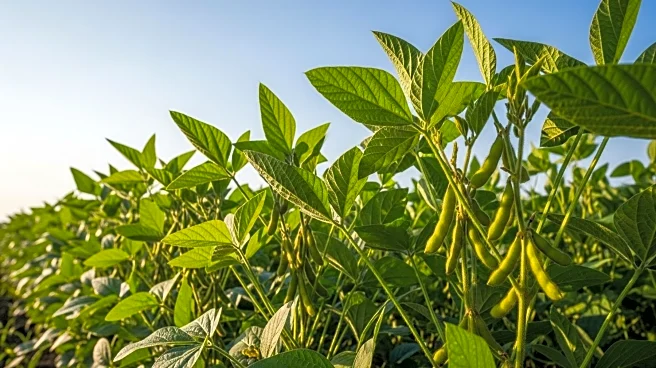What's Happening?
The USDA Crop Progress report indicates that soybean harvest is underway in 11 states, with Louisiana leading at 63% completion. This progress is ahead of the five-year average, despite challenges posed by drought conditions in various regions. Louisiana's soybean condition is rated predominantly good, while Mississippi and Arkansas also report significant harvest progress. However, states like Tennessee and Kentucky face poorer conditions, with a notable percentage of crops rated as very poor or poor. The report highlights the varying impacts of weather conditions on soybean harvest across different states, with some areas experiencing better-than-average progress and others struggling with adverse conditions.
Why It's Important?
The soybean harvest is crucial for the U.S. agricultural sector, impacting both domestic supply and export potential. The progress in states like Louisiana and Mississippi suggests resilience in the face of drought conditions, which could help stabilize market prices and ensure supply continuity. However, poorer crop conditions in states like Tennessee and Kentucky may lead to reduced yields, affecting local economies and potentially increasing reliance on imports. The situation underscores the importance of monitoring weather patterns and adapting agricultural practices to mitigate the impact of drought and ensure food security.
What's Next?
As the harvest continues, farmers and industry stakeholders will need to assess the impact of drought conditions on overall yield and quality. Strategies may include adjusting irrigation practices, exploring drought-resistant crop varieties, and enhancing soil management techniques. The USDA will likely continue to monitor crop conditions and provide updates on harvest progress, informing market forecasts and policy decisions. The ongoing situation may prompt discussions on the need for investment in agricultural research and infrastructure to support resilience against extreme weather events.
Beyond the Headlines
The soybean harvest progress amid drought conditions highlights broader environmental and economic challenges facing the agricultural sector. The situation may influence public policy debates on climate adaptation and the role of government in supporting affected industries. Long-term shifts in weather patterns could necessitate changes in land use and resource management, impacting rural communities and ecosystems. As drought conditions become more frequent, there is a growing urgency to address the root causes and develop comprehensive strategies to ensure economic and environmental sustainability.












